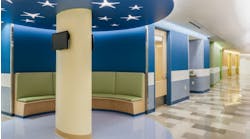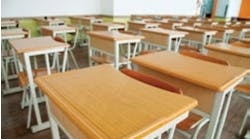Educators and administrators are looking for new ways to boost student performance and eliminate barriers to learning. When working to improve the classroom environment, facility managers typically target the physical structure, temperature controls, humidity levels and ventilation. Many heating, ventilating and air conditioning (HVAC) consultants recommend assessing the effect of improved acoustics on the learning environment.
Managing humidity and temperature is essential, but how it affects the acoustics of the environment often is overlooked.
Struggling to hear
With schools and universities spending billions of dollars on construction and renovation projects, the Acoustical Society of America (ASA) has stressed the importance of improving the acoustics of classrooms.
Classroom acoustics can directly affect students' and teachers' ability to concentrate and communicate — thus diminishing the overall learning experience. Many classrooms have speech intelligibility ratings of less than 75 percent, according to the ASA.
Acoustics is an issue for all students, not just those with learning disabilities or identified as hearing-impaired. The ideal school environment is one in which every word can be heard; students should not have to fill in three or four words in each sentence because they cannot understand them.
According to “Sound in the Classroom: Why Children Need Quiet,” published by the ASHRAE Journal, noise and reverberation — the persistence of sound after the source itself stops — adversely affect normally developing young children more than they affect typical adults. Therefore, it is difficult for a child younger than 13 to hear what is being said in a classroom if there is substantial background noise. These distractions can come from the infrastructure itself, such as the HVAC system, appliances, computers; or from children and teachers — or external sources such as highway or airport traffic.
At higher risk
Children with hearing loss and learning disabilities are affected more severely by poor acoustics. Some may be surprised to learn the magnitude of those special populations: children with temporary or permanent hearing loss “may comprise up to 15 percent of the school-age population,” according to the Centers for Disease Control and Prevention (CDC).
Including students with speech impairments or learning disabilities further magnifies these issues:
-
Those with learning disabilities. The U.S. Department of Education reports that in 2002 there were about 3.9 million children, or 8 percent of those enrolled in public elementary and secondary schools, classified as having mental retardation, emotional disturbances or a specific learning disability.
-
Those with English as a second language. A 1998 U.S. Census Bureau report states that 2.5 million school-aged children have limited English proficiency — about five to 11 percent of all school-aged children.
-
Those suffering from hearing loss, either temporary because of ear infections or more permanent conditions caused from noise damage or other illnesses or injuries. These children may have cochlear implants, small electronic devices that create sound for those who are profoundly deaf or severely hearing-impaired. These are increasingly used in children to help them understand speech and their surrounding environment.
The basics of “good acoustics”
The term “good acoustics” has become so commonplace that a clear understanding of its meaning may have been lost. In part, that is because there are many types of rooms — large lecture halls, auditoriums and gymnasiums to small classrooms and libraries — and each type has its own standards.
Classroom acoustical standards were developed by the American National Standards Institute (ANSI) and the ASA. ANSI/ASA S12.60, the standard for Acoustical Performance Criteria, Design Requirements and Guidelines for Schools, was approved in 2002. In it, learning spaces are divided into categories with maximum sound limits for each. For example, the maximum permissible background-sound level for a typical classroom is 35 dBA, with a maximum reverberation time of 0.6 to 0.7 seconds (depending on room volume). These are low levels that do not match the existing acoustical environments in many classrooms. The challenge is to design classrooms that meet children's needs, so all sound sources in a room must be considered.
Finding solutions
Schools can achieve good acoustics in the classroom if the issue is considered at the outset of the design process with collaboration among school planners, architects, contractors and suppliers. Excessive mechanical noise can be reduced substantially at little or no extra cost if the system is designed properly, according to ASA. Many factors should be considered:
-
Where the building is situated. Coupled with good landscape design, this can help keep outdoor noise at a minimum.
-
Size and shape of the classroom. Building designers should avoid open-plan classroom layouts that provide little opportunity to acoustically isolate one activity area from another.
-
Classroom placement relative to other interior spaces. Arrange these to minimize the effects of occupancy-, equipment- and environment-related noise that comes from outside the classroom walls.
-
Construction of ceilings, walls and floors. Select construction materials with the right Sound Transmission Class (STC) ratings for slab, roof and exterior walls, including doors and windows.
-
Surface treatment, which determines sound absorption.
-
Number, type and location of internal and external sound sources, and the strength of the sounds they produce.
Because an HVAC system frequently is the predominant noise source in a classroom, it must be taken into consideration during the initial design phase. HVAC equipment can fall into categories both internal (fans or compressors inside the classroom) and external (rooftop units outside or indoor units in mechanical rooms situated away from the classroom). Because the distance between the equipment and the student can play a large role in reducing noise, the quietest solutions typically entail placing equipment outside the classroom.
Acoustical prediction and analysis software can help building designers take into account different sound sources, so they can accurately predict a classroom's sound level. The software enables designers to input specific building requirements along with the type and placement of HVAC equipment, duct configuration, and wall and ceiling type. Something as simple as the size of ductwork or the use of rounded (radiused) turns as opposed to squared (mitered) turns can make a big difference.
Building designers should work closely with HVAC equipment providers to select equipment with low sound levels and to identify system designs that meet their specific acoustical goals. For example, most rooftop equipment has one compressor and a constant-speed fan. The unit fan operates continuously at high speed to satisfy the ventilation requirements. The compressor is cycled on and off based on the need for cooling or heating in the classroom. Sound levels change when the compressor cycles on and off, creating a distraction.
One solution is the use of a variable-airflow, multiple compressor unit that sequences on smaller compressors and creates less of a distraction. In addition, the unit supply fan provides only the amount of air needed to meet the ventilation and comfort requirements — thereby reducing sound levels and electrical energy consumption.
Garibay is the education and government market sales leader for Trane, a provider of indoor comfort systems and facility solutions for schools, Trane, Wis.
2002
Year that ANSI/ASA S12.60, the standard for Acoustical Performance Criteria, Design Requirements and Guidelines for Schools, was passed.




